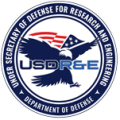Department of Defense Announces 2025 Laboratory-University Collaboration Initiative Fellows
The Department of Defense (DoD) announced the class of 2025 Laboratory-University Collaboration Initiative (LUCI) fellows today. Twenty accomplished researchers from defense laboratories make up the class of 2025 LUCI fellows.
The LUCI fellows will partner with prominent DoD-funded academic researchers – either recipients of the Vannevar Bush Faculty Fellowship or principal/co-principal investigators under the Multi-Disciplinary University Research Initiative – on projects eligible to receive up to $200,000 per year for three years.
The LUCI program, administered out of the basic research office, fosters collaboration between DoD laboratory scientists and top university scientists funded by the DoD in priority defense research areas including applied mathematics, cognitive neuroscience, engineering biology, novel materials, quantum information science, and manufacturing science.
“The LUCI fellowship is an investment that empowers our scientists to push the boundaries of discovery while building strong ties with the academic community,” said Dr. Jean-Luc Cambier, director of technical research programs in the Basic Research Office. “It provides our researchers with a unique opportunity to engage in exploratory research, pursuing transformative ideas that strengthen the department’s scientific foundation and drive future innovation.”
The selection process for the fellowship involved program officers from the U.S. Army, Navy, and Air Force, senior leadership from the Basic Research Office within the Office of the Under Secretary of Defense for Research and Engineering, and technical experts from partnering defense contractors. Out of 59 initial white papers, evaluators short-listed 22 proposals demonstrating strong potential for innovative, high-impact research.
Following a rigorous interview phase, the Basic Research Office selected 14 projects, represented by 20 principal and co-principal investigators from the military service laboratories, as the department’s 2025 LUCI cohort:
| Principal Investigator(s) | Topic | Project Title | Collaborator(s) |
|---|---|---|---|
| Anesia Auguste (Air Force Research Laboratory) | Soft Materials and Multiscale Structures | Understanding the Interaction of Mesogen Alignment in On-demand Processes | Jennifer Lewis (Harvard University) |
| Alexander Pankonien and Philip Buskohl (Air Force Research Laboratory) | Other Fields of Research | Augmented Autoencoders for Interpretable Physical Reservoir Design | Kunihiko Taira (University of California, Los Angeles) |
| Maxwell Gregoire (Air Force Research Laboratory) | Electronics, Photonics, and Quantum Materials | Cooling the Internal and External Degrees of Freedom of Levitated Microparticles | Peter Pauzauskie (University of Washington) |
| Jason Soares and Jordan Whitman (U.S. Army Combat Capabilities Development Command Soldier Center) | Fundamentals of Bio-engineering | Exploring Host-Microbiome Interaction Phenomena Through Integrated in Vitro Human Gastrointestinal Co-Culture Models | David Kaplan (Tufts University) |
| Anthony Fragoso (Cold Regions Research and Engineering Laboratory, U.S. Army Engineer Research and Development Center) | Networks and Artificial Intelligence (AI) | Automated Test Generation for Arctic AI and Autonomy | Richard Murray (California Institute of Technology) |
| Eunice Paik and Christopher Kuhs (Army Research Laboratory) | Electronics, Photonics, and Quantum Materials | Alter-fast Dynamics: Optical Studies of Engineered Altermagnetism | Chang-Beom Eom (University of Wisconsin) |
| Michael Swift (Naval Research Laboratory) | Quantum Information Science | Quantum Embedding for Quantum Defects in Wide-Band-Gap Semiconductors | Chris Van de Walle (University of California, Santa Barbara) |
| Noam Bernstein and Edwin Antillon (Naval Research Laboratory) | Materials Science | Atomistic Mechanisms of Hysteresis in Shape Memory Materials | Richard James (University of Minnesota) |
| Joseph Fiordilino (Air Force Research Laboratory) | Applied Mathematics and Computational Science | Atmospheric Propagation of High-Power Structured Laser Beams | Greg Gbrur (University of North Carolina) |
| Paula Chen (Naval Air Warfare Center Weapons Division, China Lake) | Networks and Artificial Intelligence | Physics-Informed Machine Learning for Multi-Agent Differential Games | George Karniadakis (Brown University) |
| Kenneth McClain and Benjamin Harvey (Naval Air Warfare Center) | Electronics, Photonics, and Quantum Materials | Conferring the Magnetic Anisotropy of Lanthanide Single-Molecule Magnets to Coupled Magnetic Nanomaterials | Michael Crommie (University of California, Berkeley) |
| Adam Dunkelberger (Naval Research Laboratory) | Electronics, Photonics, and Quantum Materials | Highly Anisotropic Materials for Tailored Nonlinear Optical Responses | Joshua Caldwell (Vanderbilt University) and Tony Heinz (Stanford University) |
| Alexander Efros and John Lyons (Naval Research Laboratory) | Electronics, Photonics, and Quantum Materials | Engineered Heusler Compound Heterostructures and Superlattices | Christopher Palmstrøm (University of California, Santa Barbara) |
| Kirubel Teferra (Naval Research Laboratory) | Applied Mathematics and Computational Science | Multiscale, Multifidelity Models for Control and Optimization in Additive Manufacturing | Kaushik Bhattacharya (California Institute of Technology) |
To learn more about LUCI, visit https://basicresearch.defense.gov/Pilots/Laboratory-University-Collaboration-Initiative/.

